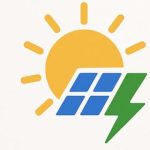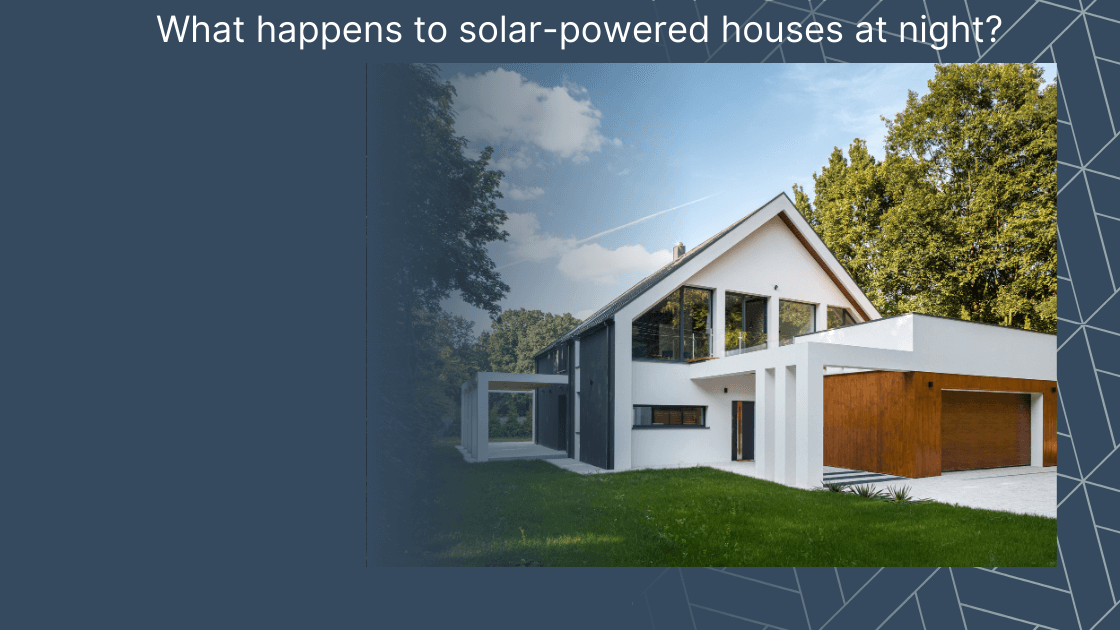Solar-powered houses have emerged as a beacon of hope in our quest for a more sustainable future, harnessing the sun’s energy to provide clean and efficient power.
Yet, a common question that arises is: what happens when the sun sets? As night falls and our planet is cloaked in darkness, how do these innovative homes continue to function?
This article delves into the mechanisms and technologies that keep solar-powered houses running smoothly, even when the sun isn’t shining, and explores the role of energy storage and smart design in making renewable energy a viable option 24/7.
What are solar-powered houses?
Solar-powered houses are residential buildings that utilize solar energy as their primary source of electricity.
These homes are equipped with solar panels, typically installed on rooftops, which capture sunlight and convert it into electrical power through photovoltaic cells.
This process allows homeowners to generate their own renewable energy, reducing reliance on traditional fossil fuels and decreasing their carbon footprint.
During the day, when sunlight is abundant, solar panels generate electricity to power the home’s appliances, lighting, and heating or cooling systems.
Excess energy produced during sunny periods can be stored in batteries for later use or fed back into the electrical grid in exchange for credits.
At night or during cloudy days when solar panels are not producing electricity, stored energy from the batteries can be used to keep the house running smoothly.
Additionally, solar-powered houses may be connected to the traditional power grid as a backup, ensuring a continuous power supply regardless of weather conditions.
By harnessing the power of the sun, solar-powered houses offer a sustainable and environmentally friendly alternative to conventional energy sources, promoting energy independence and contributing to a cleaner planet.
How do solar panels generate electricity?
Solar panels generate electricity through a process called the photovoltaic effect. Here’s how it works:
Absorption of Sunlight
Solar panels are made up of many photovoltaic cells, typically composed of silicon. When sunlight hits these cells, it excites the electrons in the silicon atoms.
Electron Movement
This excitement causes the electrons to break free from their atoms and move around. The movement of these free electrons creates an electric current.
Direct Current (DC) Electricity
The electric current generated by the movement of electrons is direct current (DC) electricity. However, most homes and appliances use alternating current (AC) electricity.
Inversion to AC
An inverter within the solar panel system converts the DC electricity into AC electricity, making it compatible with home appliances and the electrical grid.
Energy Usage or Storage
The AC electricity can then be used to power the home’s appliances and lighting. Any excess electricity can be stored in batteries for later use or fed back into the electrical grid, depending on the setup.
How is solar energy stored?
Solar energy is primarily stored in batteries, allowing homes to use the power generated during the day when the sun isn’t shining. Here’s how it works:
Battery Storage
Solar panels convert sunlight into electricity, and any excess energy produced can be stored in batteries. These batteries, often lithium-ion, store the energy as chemical energy. When the sun goes down, the stored energy can be converted back into electricity to power the home.
Types of Batteries
The most common types of batteries used for solar energy storage are lithium-ion batteries, which are known for their efficiency and long lifespan. There are also lead-acid batteries, which are more affordable but have a shorter lifespan and lower efficiency.
Energy Management Systems
Advanced energy management systems can monitor and control the flow of electricity between the solar panels, batteries, and the home’s electrical grid. These systems ensure that energy is used efficiently and stored appropriately for later use.
Grid Connection
In addition to batteries, some solar-powered homes are connected to the electrical grid. When the solar panels generate more electricity than needed, the excess can be fed back into the grid.
During nighttime or cloudy days, the home can draw electricity from the grid, ensuring a continuous power supply.
What happens when the stored energy is not enough?
When the stored energy in a solar-powered house is insufficient, the home can draw electricity from the traditional power grid.
This grid connection serves as a reliable backup, ensuring that the household remains powered even when the solar energy reserves are low.
The transition between stored solar energy and grid electricity is typically seamless, managed by an advanced energy management system that monitors the home’s energy consumption and sources.
In addition to grid electricity, some solar-powered homes utilize alternative renewable energy sources to supplement their power needs.
For instance, homes equipped with wind turbines can generate additional electricity when solar power is not enough.
Other renewable options, such as geothermal or hydroelectric systems, can also contribute to maintaining a steady energy supply.
These complementary systems work together to ensure that the home remains energy-efficient and eco-friendly, even when solar energy is scarce.
To further mitigate the risk of running out of stored energy, homeowners can adopt energy-efficient practices and technologies.
This includes using energy-efficient appliances, smart home systems that optimize power usage, and implementing energy-saving habits such as turning off lights and devices when not in use.
By combining these strategies with solar power and backup solutions, solar-powered homes can maintain a consistent and reliable energy supply, minimizing their reliance on traditional fossil fuels.
How can homes be more energy-efficient?
omes can be made more energy-efficient through a combination of smart design, modern technology, and sustainable practices. Here are some key strategies:
Energy-Efficient Appliances
Using appliances that are designed to consume less energy can significantly reduce a home’s overall energy usage.
Look for products with high energy ratings and ENERGY STAR certification, which indicates they meet strict energy efficiency guidelines.
Insulation and Sealing
Proper insulation and sealing of a home prevent heat loss during the winter and keep it cool in the summer.
This reduces the need for heating and cooling, which are typically the largest energy consumers in a home. Key areas to insulate include walls, attic, and floors, and sealing gaps around windows and doors.
Smart Home Systems
Smart thermostats, lighting systems, and appliances can optimize energy usage by learning your habits and adjusting accordingly.
For example, a smart thermostat can lower the heating when you’re not home and turn it back up just before you return.
Energy-Efficient Lighting
Replacing traditional incandescent bulbs with LED or CFL bulbs can drastically reduce energy consumption. These bulbs use significantly less power and have a much longer lifespan.
Solar Panels and Renewable Energy
Installing solar panels can provide a renewable source of energy, reducing reliance on the grid. Additionally, consider using other renewable energy sources like wind or geothermal, depending on your location and feasibility.
Water Heating
Using energy-efficient water heaters, insulating hot water pipes, and reducing hot water usage through low-flow fixtures can help save energy.
Windows and Doors
High-performance windows and doors reduce heat transfer, helping maintain a consistent indoor temperature. Double or triple-glazed windows are particularly effective.
Energy Monitoring
Regularly monitor your home’s energy consumption to identify and eliminate inefficiencies. Many smart devices can provide real-time data on energy usage.
Are there successful examples of solar-powered houses?
Yes, there are many successful examples of solar-powered houses around the world. Here are a few notable ones:
The Solar Decathlon
This is an international competition organized by the U.S. Department of Energy, where teams from universities around the world design and build solar-powered houses.
These homes are often highly innovative and showcase the latest in solar technology and sustainable design.
The Tiny House Movement
Many tiny houses are designed to be off-grid and rely entirely on solar power. These compact homes are not only energy-efficient but also promote a minimalist and sustainable lifestyle.
Passive Solar Homes
These homes are designed to maximize the use of natural sunlight for heating and lighting. They often feature large south-facing windows, thermal mass materials, and other design elements that help regulate indoor temperatures without the need for additional heating or cooling systems.
Net-Zero Energy Homes
These homes produce as much energy as they consume over the course of a year, thanks to a combination of solar panels, energy-efficient appliances, and smart home technology.
They are becoming increasingly popular as people seek to reduce their carbon footprint and energy bills.
Why is solar power a viable energy source?
Solar power is a viable energy source for several compelling reasons:
Renewability
Solar energy is an abundant and inexhaustible resource. The sun provides more energy to the Earth in one hour than the entire world uses in a year.
As long as the sun continues to shine, we can harness its power, making solar energy a sustainable choice for the long term.
Environmental Benefits
Solar power generates electricity without producing harmful emissions or pollutants, unlike fossil fuels which contribute to air and water pollution, greenhouse gas emissions, and climate change.
By adopting solar energy, we can reduce our carbon footprint and mitigate the adverse effects of climate change.
Economic Advantages
Advances in solar technology have significantly reduced the cost of solar panels and installation. Additionally, government incentives, tax credits, and subsidies can make solar power more affordable for homeowners and businesses.
Over time, solar power can lead to substantial savings on energy bills, as the initial investment is offset by the reduced reliance on traditional energy sources.
Energy Independence
Solar power enables individuals and communities to generate their own electricity, reducing dependence on centralized power grids and fossil fuel imports.
This energy independence enhances resilience to power outages and energy price fluctuations, providing greater control over energy supply and costs.
Technological Advancements
Continuous improvements in solar technology, such as more efficient photovoltaic cells and innovative energy storage solutions, have made solar power more efficient and accessible.
These advancements are expanding the potential applications of solar energy, making it an increasingly viable option for a wide range of energy needs.
Conclusion
Solar-powered houses represent a significant step towards a more sustainable and eco-friendly future. By harnessing the sun’s energy, these homes reduce reliance on fossil fuels and lower carbon emissions, contributing to a cleaner environment.
The combination of solar panels, efficient energy storage solutions, and smart home technologies ensures that these houses can maintain a steady supply of electricity even when the sun isn’t shining.
While there are challenges, such as energy storage and the need for backup solutions, the advancements in solar technology and renewable energy sources make solar-powered houses a viable and attractive option for many.
By adopting energy-efficient practices and integrating alternative energy sources, homeowners can further enhance the efficiency and reliability of their solar-powered homes.
Overall, the transition to solar energy not only provides environmental and economic benefits but also promotes energy independence and resilience.
As technology continues to advance, the future of solar-powered houses looks bright, offering a sustainable and reliable energy solution for generations to come.

